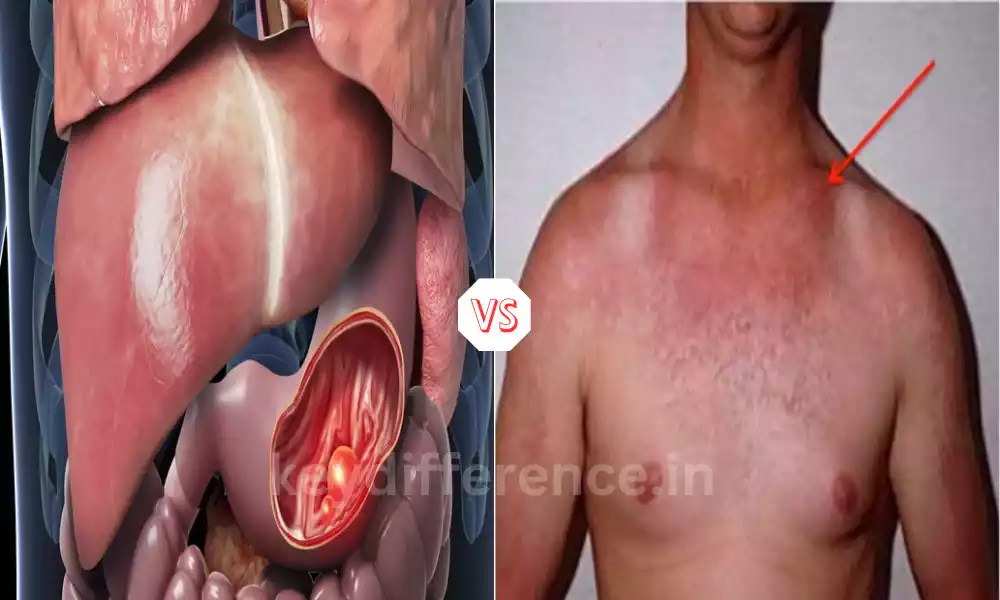In the realm of diseases, discerning between Lipoma and Hematoma is vital for a precise diagnosis and the appropriate treatment. Lipomas and hematomas can appear as lumps beneath the skin, however, they differ in terms of their origin, causes, and treatments.
This short guide will highlight the main differences between the two types of conditions, and provide insight into the definitions of each, their clinical features and diagnostic techniques as well as treatment options. the reasons why it is crucial to distinguish from them within a medical situation.
Definition of Lipoma
A lipoma is a benign non-cancerous development of fatty tissue cells, which typically form in the skin just below the surface. The soft, slow-growing, and generally painful lumps are among the most commonly encountered kinds of tumors in soft tissues. Lipomas are typically harmless, however, they could be removed surgically in cases where they cause pain, discomfort, or cosmetic issues.

Definition of Hematoma
Hematomas are a localized collection of blood that has been escaping from blood vessels and then accumulated in the tissue surrounding it, often due to injuries or trauma.
Hematomas may occur in the body or beneath the skin. They are usually manifested by swelling, discoloration (bruising) as well and discomfort at the location of the injury.
They may differ in severity and size, and treatment can vary from conservative treatment to surgical treatment, depending on the specific situation as well as the dimensions of the hematoma.

Comparison Table of Lipoma and Hematoma
Here’s a comparison table highlighting the key differences between lipoma and hematoma:
| Characteristic | Lipoma | Hematoma |
|---|---|---|
| Nature | Benign, non-cancerous fatty tissue growth | Accumulated blood outside blood vessels |
| Causes | Typically of unknown cause, genetic factors may play a role | Trauma or injury that damages blood vessels |
| Location | Commonly found just beneath the skin, but can occur in various body parts | Can occur both subcutaneously (beneath the skin) and internally |
| Texture | Soft, rubbery, and mobile when touched | Initially firm, becomes softer as it resolves |
| Pain | Usually painless, although it may cause discomfort if it presses on nerves | Often accompanied by pain or tenderness, especially when touched |
| Color | No noticeable discoloration of the skin | Typically associated with bruising and skin discoloration |
| Growth rate | Slow-growing can take years to reach a noticeable size | Rapid onset and enlargement following trauma, then gradual resolution |
| Diagnostic methods | Physical examination, imaging techniques (ultrasound, MRI) | Physical examination, imaging (CT scan, ultrasound), and sometimes aspiration |
| Treatment options | Observation, surgical removal for cosmetic or discomfort reasons | Conservative management, drainage or aspiration, surgical intervention in severe cases |
| Recurrence | Rarely recurs once surgically removed | Rarely recurs if properly managed, may reaccumulate if the underlying cause persists |
| Long-term implications | Generally benign with no long-term health concerns | Depends on the underlying cause and location; may lead to complications if untreated |
This table provides a quick overview of the main distinctions between lipoma and hematoma, helping to differentiate these two conditions based on various characteristics and clinical aspects.
Importance of distinguishing between lipoma and hematoma
Differentiating between hematoma and lipoma is essential for a variety of reasons since both are distinct in terms of diagnosis and treatment as well as the patient’s health.
Here are a few reasons for distinguishing between the two:
- The most appropriate treatment: Accurate differentiation between lipoma and hematoma is vital in determining the most appropriate treatment method. Lipomas are generally benign and are often removed just for cosmetic reasons or to alleviate discomfort. Hematomas, on the other hand, may require different treatments based on the size of the tumor, its location, and the underlying cause. Unintentional diagnosis and improper treatment can result in excessive procedures or problems.
- Medical Management: Hematomas usually result from injury or trauma, and treatment may include treatment of the causes to stop further bleeding. The inability to detect the presence of a hematoma could result in unnoticed injuries or illnesses that require special care like injuries to the vascular system or fractures.
- Patient comfort: Hematomas may be uncomfortable and painful, particularly when the hematomas are large and situated in areas that are sensitive. A precise diagnosis allows healthcare professionals to manage pain and determine if surgical intervention is required to remove the hematoma.
- Preventing Recurrence: Hematomas can develop again when the root causes are not taken care of. Finding and fixing the root of the issue like a bleeding condition or vascular injury can prevent the repeat occurrence of hemomatomas.
- Cosmetic Concerns: Lipomas are usually removed because of cosmetic reasons or when they pose aesthetic issues on the part of patients. An accurate diagnosis can ensure that patients receive the appropriate guidance and treatment options that are tailored to their specific needs in terms of cosmetics.
- Patient education: Communication with the patient about their condition and options for treatment is vital to make informed decisions. Differentiating between hematoma and lipoma can help healthcare professionals educate patients about their diagnosis, prognosis, and treatment options.
- Avoiding unnecessary surgery: Misdiagnosing a lipoma as a hematoma reversely could cause unnecessary surgical procedures that could pose risks and complications. An accurate diagnosis will help you avoid unnecessary procedures when they aren’t required.
- Efficiency in the use of resources: Healthcare resources, including medical facilities and time, are limited. A precise diagnosis will ensure that these resources are utilized effectively, thus reducing the need for testing and other procedures.
Recognizing lipoma and hematoma is vital for providing appropriate and customized treatment to patients, avoiding unnecessary procedures, treating the root causes, treating discomfort and pain, and guaranteeing the best outcomes to ensure the health and well-being of patients.
Prognosis and long-term implications
The prognosis and the long-term consequences of hematomas and lipomas differ substantially due to their distinctive characteristics and their causes.
This article will take a closer analysis of the prognosis and the long-term consequences of each of the conditions:
Lipoma:
- A Prognosis: They are usually regarded as benign and have the lowest risk of turning into cancer. After removal surgically, they usually do not recur in the same site and the majority of patients have an entire recovery.
- Long-term implications: There aren’t any effects over the long term that can be attributed to lipomas. After removal by surgery, patients should expect relief from any discomfort or aesthetic issues caused by the lipoma. It’s important to keep in mind that, while lipomas in themselves aren’t usually a reason for concern, however, the presence of multiple lipomas or certain features may require further examination to rule out unusual conditions such as lipomatosis.
Hematoma:
- The prognosis for HTML0: The prognosis for hemorrhagic hematomas is based on a variety of variables, including its size, location of reason, and speed of treatment. Hematomas that are small in size, particularly ones that result from minor injuries, tend to heal by themselves with adequate treatment. However, deeper or larger hematomas, particularly those result from traumas that are severe or medical conditions that are underlying could require more thorough treatment and could result in complications.
- Long-term implications: Long-term implications of hematomas can differ
- Minor Hematomas: Subcutaneous, small, and uncomplicated Hematomas usually disappear without any significant long-term consequences once the bleeding is managed.
- Complications: If a hematoma is infected, causes damaged tissue, or affects crucial structures (e.g. the hematoma is causing pressure on nerves or blood vessels that are vital) could have long-term effects. In some instances complications, they may require additional operations or treatments.
- Recurrent Hematomas: Identifying and fixing the root cause of recurrent hematomas are essential to prevent their recurrence. For example, if the hematoma is caused by an underlying bleeding disorder, continuous medical treatment may be required.
The outlook and long-term consequences of lipomas tend to be favorable with little or no concern for the long term when they are surgically removed. However, the outlook for hematomas may differ according to factors like size, location of the cause, and timely medical intervention.
It is essential for healthcare professionals to examine each case in a separate manner and give the appropriate treatment to maximize the outcome and avoid possible complications.
Case studies illustrating the differentiation process
Here we have two cases that demonstrate the process of differentiation between hematoma and lipoma:
Case Study 1: Lipoma vs. Hematoma
Patient Profile:
- Patient A is a male aged 45.
- A lump is thrown up on the back of the upper part
- There is no evidence of recent trauma.
Clinical Presentation:
- A tender lump that is painless and located below the skin on the upper back.
- It is also mobile, and it has been increasing over the last year.
- There is no bruising or discoloration on the skin that covers the lump
- There is no discomfort or pain.
Diagnostic Process:
- Physical Examining: The lump is soft, flexible, and non-injurious upon palpation which is in line with the characteristic of the lipoma.
- Imagery: An ultrasound reveals the presence of a homogenous, well-circumscribed mass that exhibits the characteristics of a lipoma. It also reveals its fat composition.
- Diagnostics: Based on the image and clinical findings The healthcare professional is able to diagnose Patient A as having an adenocarcinoma.
Outcome:
- Patient A is advised of the fact that this lump harmless lipoma that does not need immediate removal except if it creates discomfort, or causes cosmetic issues.
- The patient decides to keep an eye on the lipoma since it’s painless and doesn’t cause any discomfort.
- Regular appointments will be scheduled to monitor modifications in the appearance or size that the tumor.
Case Study 2: Lipoma vs. Hematoma
Patient Profile:
- Patient B is a 30-year-old female
- The patient is presented with a lump on the thigh
- A fall that caused an injury in the hip two days earlier
Clinical Presentation:
- A small lump of tenderness on the thigh. It is accompanied by large skin bruises
- The lump is hard and it is painful to touch.
- The patient experiences localized swelling and pain in the affected area.
- No evidence of similar lumps or masses in the past
Diagnostic Process:
- Physical Examining: The lump is soft, and firm and is accompanied by prominent pigmentation of the skin (bruising). The presence of tenderness, pain, and recent trauma increases the possibility of a hemorrhage.
- Imagery: An ultrasound is conducted, which shows a plethora of fluid that is consistent with a hemorrhage. The ultrasound can confirm the diagnosis and determine the size of the hemorrhage.
- Diagnostics: Patient B is diagnosed with a hematoma which results from a recent trauma in the lower thigh.
Outcome:
- The doctor explains that it is a hematoma. which is a blood clot that resulted from the accident and fall.
- Patient B is advised about the normal course of a hemorrhage which is an in-between resolution while the body is able to absorb the blood.
- The patient receives instructions to manage pain and is advised to keep track of the progress of the hematoma.
- A follow-up appointment will be scheduled to evaluate the healing of the hematoma as well as make sure there aren’t any complications.
These case studies highlight the importance of conducting a thorough medical evaluation, which includes an examination of the body and imaging whenever necessary, to discern between hematomas and lipomas.
The absence or presence of specific characteristics of the clinical examination, such as discomfort, tenderness, discoloration, and the history of the patient, play an important role in determining the right diagnosis and subsequent treatment.
Encouragement for seeking medical advice for any suspicious lump or injury
Getting medical advice promptly in the event of a suspicious bump or ailment is of utmost importance to your overall health and well-being.
Here’s some motivation and reasons to never be afraid to seek advice from a medical expert:
- Early Detection Helps Save Lives: Many serious medical illnesses, such as cancer, are treatable when discovered in their early stages. An apparent lump could be an indication of something more serious, and an early diagnosis could result in better treatment options.
- peace of mind: Consultation with an expert in healthcare can give peace of mind, either by eliminating serious problems or making sure the proper measures are taken to diagnose and treat. It is better to be aware than worry about the unknowable.
- Quick intervention: For injuries or trauma, prompt medical attention can avoid complications and accelerate the healing process. In the event of a delay, it can worsen the injury or cause more complications.
- Professional Assessment: The healthcare professionals are equipped with the training, knowledge, and expertise to correctly evaluate your health condition. They will provide a precise diagnosis and suggest the most appropriate treatment plan that is tailored to your specific needs of.
- Preventing progression: Addressing medical concerns early will stop the condition from deteriorating. Certain medical conditions can progress quickly, and prompt intervention is crucial.
- Reducing anxiety: The inability to ignore an injury or lump that is suspicious could lead to increased anxiety and anxiety. A medical professional can help you relax and provide you with a more clear path.
- Accessibility to Specialist Care: Healthcare professionals can recommend you to specialists when they are required. Specialist care can make a huge difference in the diagnosis and management of difficult medical illnesses.
- Protection of your overall health: Your health is essential. Getting medical guidance not only addresses the problem at hand but also improves your overall health and prolongs your life.
- Assistance and Guidance: Healthcare professionals don’t just provide medical treatments, but provide guidance, education as well as emotional assistance. They can answer any questions you may have and assist you in making informed choices about your health.
- Controlling Your Health: Proactively seeking medical guidance will help you manage your health. It’s a responsible and empowered step toward a healthier, happier future.
Keep in mind that healthcare professionals will be there to help you, and they are devoted to your health and well-being. If you notice an unusual lump, suffer an injury, or have any health concerns, do not be afraid to seek medical guidance. It’s an informed and thoughtful decision that will positively impact your life.
Similarities Between Lipoma and Hematoma
Although hematomas and lipomas are vastly different in regards to their composition as well as their causes and treatment.
There are some similarities between the two conditions:
- Physical Prevalence: Both lipomas and hematomas appear as visible lumps or masses below the skin or within the body. Patients might notice an increase in size or lumps in an affected region in both instances.
- Potentially Discomfort: Both hematomas and lipomas may cause discomfort or discomfort. Lipomas can cause discomfort if they press against tissue or nerves surrounding them and hematomas can be painful, particularly when they are larger or located in zones with sensitive tissues.
- Diagnosis by Examining: Healthcare professionals typically conduct physical examinations to determine the presence of lipomas as well as hematomas. The test involves rubbing the lump and then evaluating its characteristics, like size, position as well as texture, and tenderness.
- Imaging to Confirm: In certain cases, medical imaging techniques like ultrasound MRI, or CT scans are used in order to verify the presence of lipomas as well as hemomatomas. Imaging may help to determine the nature and size of the tumor or collection.
- Alternative Treatments: While the treatment methods differ in lipomas and hematomas, both are treated by medical intervention if needed. Lipomas may be removed surgically for aesthetic or comfort reasons, whereas hematomas might require aspiration, drainage, and surgical treatment, specifically in cases where they are large, or cause complications.
- Potential Complications: Both hematomas and lipomas could cause complications. For lipomas, complications are not common but can result from the growth of the tumor or infection. Hematomas could be infected, or result in tissue damage that requires additional treatment.
It’s important to recognize that, despite the similarities, hematomas and lipomas are two distinct diseases with different reasons and features. An accurate diagnosis by a medical expert is vital for ensuring appropriate treatment and the best possible outcome for the patient.
Reference Books
Certainly, here are some reference books on various topics that you might find useful:
Medicine and Healthcare:
- “Harrison’s Principles of Internal Medicine” by Dan L. Longo, et al.
- A comprehensive textbook covering various aspects of internal medicine.
- “Gray’s Anatomy for Students” by Richard Drake, et al.
- An excellent resource for understanding human anatomy.
- “The Merck Manual of Diagnosis and Therapy” by Robert S. Porter and Justin L. Kaplan.
- A trusted medical reference guide for diagnosing and treating various medical conditions.
Science and Popular Science:
- “Cosmos” by Carl Sagan.
- A classic exploration of the universe and our place in it.
- “A Short History of Nearly Everything” by Bill Bryson.
- A fascinating journey through the history of science and the universe.
- “Sapiens: A Brief History of Humankind” by Yuval Noah Harari.
- An exploration of the history and impact of Homo sapiens on the world.
Technology and Computer Science:
- “Introduction to the Theory of Computation” by Michael Sipser.
- A foundational text for understanding the theory of computation and algorithms.
- “The Pragmatic Programmer” by Andrew Hunt and David Thomas.
- Offers practical advice and insights for software developers.
- “Artificial Intelligence: A Modern Approach” by Stuart Russell and Peter Norvig.
- A comprehensive introduction to AI and machine learning.
History:
- “A People’s History of the United States” by Howard Zinn.
- Presents American history from the perspective of marginalized groups.
- “Guns, Germs, and Steel: The Fates of Human Societies” by Jared Diamond.
- Explores the factors that shaped human history and civilizations.
- “The Wright Brothers” by David McCullough.
- A biography of the pioneers of aviation.
Conclusion
The distinction between hematoma and lipoma is essential for a proper assessment and therapy. Although they share superficial similarities their causes, traits, and long-term consequences are quite different.
Getting medical advice concerning lumps or injuries is an effective step towards keeping your health in good shape and ensuring prompt intervention when needed. Early detection and the right treatment can make a huge difference to your overall health and general quality of life.







